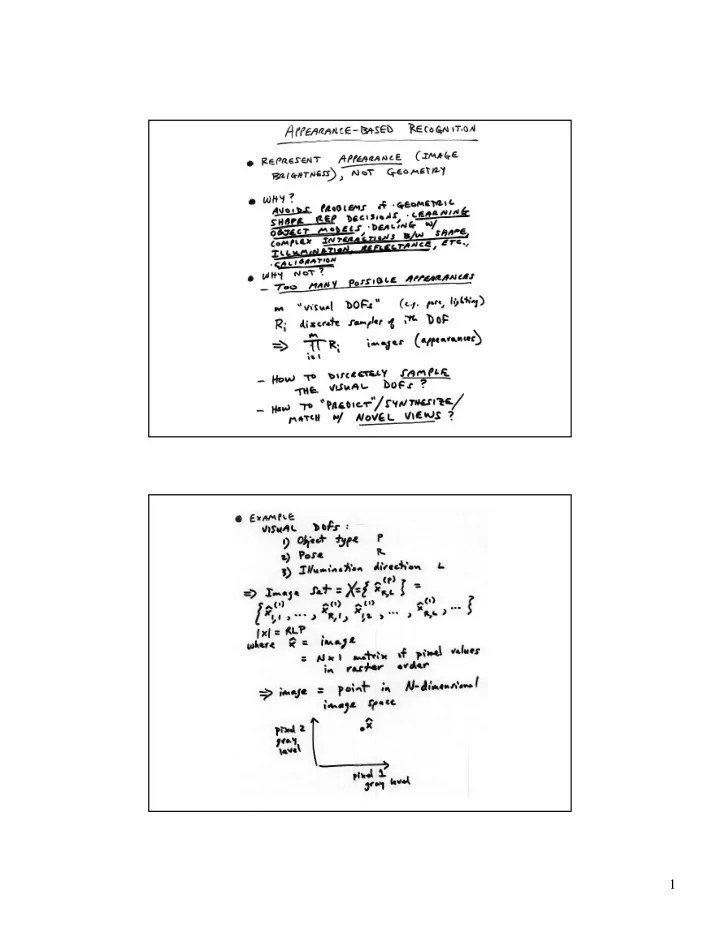

1
The Space of Faces = + • An image is a point in a high dimensional space – An N x M image is a point in R NM 2
Linear Subspaces convert x into v 1 , v 2 coordinates What does the v 2 coordinate measure? - distance to line - use it for classification—near 0 for orange pts What does the v 1 coordinate measure? - position along line - use it to specify which orange point it is • Classification is still expensive – Must either search (e.g., nearest neighbors) or store large PDF’s • Suppose the data points are arranged as above? – Idea—fit a line, classifier measures distance to line Dimensionality Reduction How to find v 1 and v 2 ? • Dimensionality reduction – We can represent the orange points with only their v 1 coordinates • since v 2 coordinates are all essentially 0 – This makes it much cheaper to store and compare points – A bigger deal for higher dimensional problems 3
Linear Subspaces Consider the variation along direction v among all of the orange points: What unit vector v minimizes var ? What unit vector v maximizes var ? Solution: v 1 is eigenvector of A with largest eigenvalue v 2 is eigenvector of A with smallest eigenvalue Principal Component Analysis • Suppose each data point is N-dimensional – Same procedure applies: – The eigenvectors of A define a new coordinate system • eigenvector with largest eigenvalue captures the most variation among training vectors x • eigenvector with smallest eigenvalue has least variation – We can compress the data by only using the top few eigenvectors • corresponds to choosing a “linear subspace” – represent points on a line, plane, or “hyper-plane” 4
Dimensionality Reduction • The set of faces is a “subspace” of the set of images – Suppose it is K dimensional – We can find the best subspace using PCA – This is like fitting a “hyper-plane” to the set of faces • spanned by vectors v 1 , v 2 , ..., v K • any face 5
Eigenfaces • PCA extracts the eigenvectors of A – Gives a set of vectors v 1 , v 2 , v 3 , ... – Each one of these vectors is a direction in face space • what do these look like? Projecting onto the Eigenfaces • The eigenfaces v 1 , ..., v K span the space of faces – A face is converted to eigenface coordinates by 6
7
Recognition with Eigenfaces • Algorithm 1. Process the image database (set of images with labels) • Run PCA to compute the eigenfaces • Calculate the K coefficients for each image 2. Given a new image (to be recognized) x , calculate K coefficients 3. Detect if x is a face 4. If it is a face, who is it? • Find closest labeled face in database • nearest-neighbor in K-dimensional space 8
9
10
11
Limits of PCA • Attempts to fit a hyperplane to the data – can be interpreted as fitting a Gaussian, where A is the covariance matrix – this is not a good model for some data • If you know the model in advance, don’t use PCA – regression techniques to fit parameters of a model • Several alternatives/improvements to PCA have been developed – LLE: http://www.cs.toronto.edu/~roweis/lle/ – isomap: http://isomap.stanford.edu/ – kernel PCA: http://www.cs.ucsd.edu/classes/fa01/cse291/kernelPCA_article.pdf – For a survey of such methods applied to object recognition • Moghaddam, B., "Principal Manifolds and Probabilistic Subspaces for Visual Recognition", IEEE Transactions on Pattern Analysis and Machine Intelligence (PAMI) , June 2002 (Vol 24, Issue 6, pps 780-788) http://www.merl.com/papers/TR2002-13/ 12
13
14
15
16
17
18
Recommend
More recommend